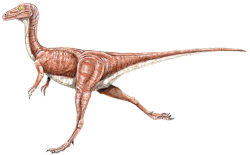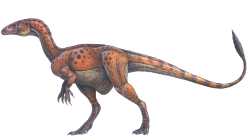|
Compsognathidae |
|
The Compsognathidae is a group of small, lightly-built coelurosaurs
with relatively long legs and tails. They have three-fingered hands. The
genera contains only three members.
Compsognathus was for many years the smallest known dinosaur.
It was
a bird-like dinosaur that walked on two long, thin legs; it had
three-toed feet. A long tail acted as a counterbalance and for
stability during fast turns. It had short arms with two clawed fingers
on each hand. Compsognathus had a small, pointed head with small,
sharp teeth, hollow bones, and a long, flexible neck.
was 28
inches long and weighted about 6.5 pounds, about the size of a house
cat. It lived in the late
Jurassic period, about 155 to 145 million years ago.
Compsognathus was discovered by Dr. Oberndorfer in limestone deposits in the Riedenburg-Kelheim region of Bavaria, southern Germany in the late
1850's. It was named by Johann A. Wagner in 1859. Only two
Compsognathus fossils have been found; one in Germany and one in
France. The latter is on display at the
Paleontological Museum.
A lizard skeleton still remains in its
abdominal cavity.
Compsognathus is believed by many scientists to be an early elative
of Archaeopteryx, often considered to be the first bird.
Supporting this belief is the fact that the bone structure of
Compsognathus is quite similar to that of Archaeopteryx, and the two
dinosaurs were about the same size. They also lived at the same time
in history, which would have made it difficult for Compsognathus to be
an ancestor. It is still possible, though, that Compsognathus lived
earlier than
Archaeopteryx. On the other side of the argument,
Compsognathus had hollow bones,
like modern birds, but Archaeopteryx had solid bones. Another
objection is that Compsognathus doesn't have a collar bone, and many
scientists believe birds' wishbones must have evolved from an animal
with a collarbone. But while Compsognathus didn't have a collar bone,
perhaps one of its relatives did.
Compsognathus was the sole member
of this genera until the discovery of Sinosauropteryx in 1990.
This new discovery was remarkable in that it had feathers. A 3rd
species was discovered in 2004. |
 |
Compsognathus longipes
- 155 - 145 MYA
Compsognathus was
the first reasonably complete dinosaur skeleton ever found. Archeopteryx, the early feathered reptile,
long regarded as
the first bird, was found at the same site as the original
Compsognathus fossils at about the same time. No feathers
have been found for
Compsognathus,
but some scientists believe that they had them. |
 |
Sinosauropteryx prima -
130 MYA
Sinosauropteryx has been called one of the most exciting
scientific discoveries in decades. This Chinese fossil clearly
shows defined feathers around much of this little dinosaur! It was
a small, swift hunter that could not fly, but it seems to
demonstrate that dinosaurs were beginning to look and act more
like birds. |
|
|
Huaxiagnathus orientalis - 125 MYA
(Hwang, S. H., M. A.
Norell, Q, Ji, and K.-Q. Gao. 2004)
This is a large (4 1/2 ft long) compsognathid theropod from the
Early Cretaceous Yixian Formation deposits of Liaoning Province.
The holotype specimen is nearly complete, lacking only the distal
portion of the tail. Like all compsognathids, Huaxiagnathus
has short forelimbs and a relatively unspecialised coelurosaur
body plan. The phylogenetic position of Huaxiagnathus orientalis
is placed at the base of the Compsognathidae, as it lacks the
forelimb adaptations of more derived compsognathids.
|
|
|
|
|
|
|
|
|
Edugraphics.Net | Feenixx Publishing |
|
|
|
|
|
![]()

